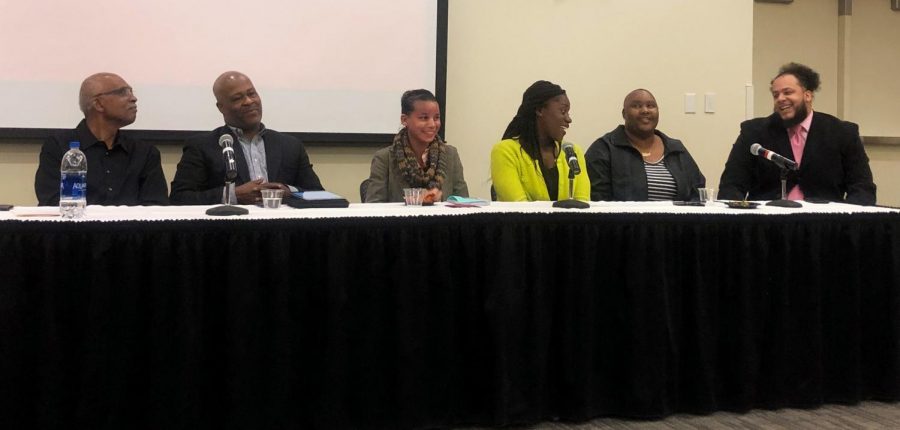Alumni rise to show their PRIDE
Alumni of Hamline’s Black Student Collective, formerly known as PRIDE, discussed their experiences at a Feb. 19 panel.
Left to right, Hamline alumni Willie Johnson, Eric Goodlow, Laura Mann Hill, Jamesetta Collins, Tottiana Duffy and Alex Leonard share their stories from their time at Hamline.
February 27, 2019
While 2019 marks 50 years of the Black Student Collective’s (BSC) presence at Hamline, it only marks one year with that name. Throughout the previous 49 years, the organization was known as Promoting Racial Identity, Dignity and Equality (PRIDE). They rebranded at the beginning of this academic year so as not to confuse or co-opt the term now strongly associated with the LGBTQ+ community. This Black History Month is the organization’s first with the new name, and their annual theme is “Still We Rise: Celebrating 50 Years of Black Excellence at Hamline University.”
On Feb. 19, six BSC alumni returned to their alma mater for a discussion panel in Anderson Forum. They were Willie Jackson ‘75, former Oracle Sports Editor and now a communications professor at Normandale Community College; Eric Goodlow ‘93, who works in risk management for Medtronic; Alex Leonard ‘02, a school counselor; Laura Mann Hill ‘06, a teacher and playwright; Jamesetta Collins ‘14, a law student at Mitchell Hamline; and Tatiana Duffy ‘18, a Securitas security officer and dance teacher. The conversation focused on their experiences in the BSC, known as PRIDE for all of their years at Hamline, and how it has carried them forward in life.
“When I got [to Hamline], it was not long after PRIDE got organized,” Jackson said. “It was kind of a refuge. We didn’t have a house, they had something called a ‘black floor’” in Peterson Hall.
The BSC has had several neighborhood houses associated with it throughout its history, often serving as the residence for numerous members.
“PRIDE was home. I came to it late,” Leonard said. “My first year I just kind of played football and kept to myself.” Yet the following year he joined the BSC after much encouragement from members. Leonard stated that when he first arrived at Hamline, he believed there were only about seven other black men on campus and that the BSC was having a difficult time recruiting male members, a disparity that still persists today.
Despite looking back fondly on their years in the BSC, the panelists recalled incidents of pressure, hardship and prejudice stemming from the Hamline community at large.
“Every year I was here… One of our fellow black students went off the deep end,” Jackson said in response to a question about mental health.“There was a hospital down the street called Samaritan, and we would have to rush somebody because it became too much.”
Leonard described an incident involving a white adjunct professor who brought cotton into a black history class, while Hill remembered being stopped by a security officer while walking across campus with her friends on an autumn night.
“We were always singing across campus, just being loud, just having fun,” Hill said of the memory. Then, the officer stopped the group and asked for their Hamline IDs, yet ignoring similarly behaved groups of white students.
The panelists all stressed how they turned to one another in times of sorrow and joy. Duffy recalled how she and other members would sit in Anderson Center late at night to “debrief” and “just let go of everything that was going on,” eventually starting a hip-hop group. Jackson described attending a campaign stop during Rep. Shirley Chisholm’s 1972 run for the presidency, saying that he and other BSC members “got really militant looking” as Chisholm, the first black woman to run for president, had no bodyguards or escorts accompanying her at her speech. Goodlow recollected a “music fight” with fellow residents of his dorm during the Gulf War, stating that one side of his floor was predominantly BSC members and another was primarily white students supportive of the war.
“We’d be walking to the stadium, and all you’d hear blaring across campus was ‘I’m Proud to be an American’ [by Lee Greenwood],” Goodlow said. “We never really addressed it. It was just there. We were kids.”
Such unspoken awkwardness, Leonard thought, is not uncommon between contrasting groups during early adulthood.
“I guess I would say, looking back 20 years, the stakes were so low that it was hard for me to gauge, what is racial tension? You’re 18 to 22 for the most part. You’re still figuring out who you are. And I would say take advantage of that,” Leonard said. “You get the time now, as people are still forming their identities and figuring out who they are, to have those conversations.”


